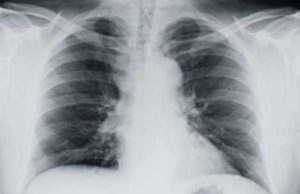
What is Malignant Mesothelioma?
Malignant mesothelioma is a rare form of cancer that develops from the transformation of cells in the mesothelium–the two-layered membrane shields several organs in the body, including the lungs and heart. Malignant mesothelioma is widely connected to prolonged asbestos exposure; individuals who worked with the mineral for decades are at severe risk of contracting mesothelioma and other asbestos-related cancers.
Asbestos, when disturbed, releases cancerous filaments into the air. When these carcinogens are inhaled, over a period of 25 to 50 years, they eat away at the protective tissues of the body and form tumors. The destruction of these tissues, including the mesothelium, gives way to rapid proliferation. When malignant mesothelioma metastasizes beyond its origin point, the disease is ruled inoperable.
Although malignant mesothelioma is uncommon (approximately 2,500 diagnoses are affirmed each year), those who have worked in asbestos-related industries are at severe risk of developing the cancer.
In the bulk of mesothelioma cases, the tumors form in the lining of the chest cavity or the lungs. Symptoms associated with mesothelioma include: painful breathing, difficulty swallowing, night sweats, pleural effusion (congregation of fluids in the pleural cavity), persistent coughing, severe chest pains, bowel obstruction and severe weight loss.
Malignant mesothelioma carries with it an extremely grim prognosis. Bleak life expectancy mesothelioma statistics are widely due to the fact that the cancer is nearly impossible to detect or diagnose.
Delayed diagnosis is common for mesothelioma cases because of the cancer’s slow-developing symptoms; signs of malignant mesothelioma are not observable until 25-50 years following the patient’s initial exposure to asbestos. Moreover, diagnostic complications derive from the innocuous cellular structure of malignant mesothelioma; the disease is nearly impossible to detect without the aid of advanced imaging systems.
Malignant mesothelioma treatment options are dependent on the disease’s progression at the time of diagnosis. Like other forms of cancer, malignant mesothelioma is documented by stage. The stage of malignant mesothelioma is elastic to the cancer’s proliferation. For instance, at its final stage (stage IV) the cancer presents widespread proliferation to several remote locations, rendering the disease incurable and inoperable.
Because of the delayed diagnosis, malignant mesothelioma sufferers face a grim life; the majority of mesothelioma patients, survive only 4 to 18 months after a formal diagnosis is secured.
Malignant mesothelioma is observed in three distinct forms: pleural (the most common form of malignant mesothelioma), pericardial and peritoneum. The Pericardium variety takes place in the tissues that protect the lungs; peritoneum mesothelioma terminates the tissues that line the abdomen (the peritoneum); and pleural mesothelioma, develops from a transformation in the pleura, which is the thin network of cells that lubricate and surround the chest wall and lungs.
Regardless of the form, mesothelioma cancer will be diagnosed in one of the following stages:
Stage I Mesothelioma: The first stage of malignant mesothelioma features a localized tumor that may be found in the sac surrounding the heart, the chest cavity or the lungs. Diagnosing malignant mesothelioma in its first stage is exceptionally rare. Those mesothelioma sufferers lucky enough to receive stage 1 diagnosis are typically eligible for curative surgery or other treatment options to cure the disease. Curative mesothelioma treatment methods aim to extract the cancerous tumors from the body.
Stage II Mesothelioma: When malignant mesothelioma evolves into to its second stage, the tumor proliferates beyond the origin point. In stage II, the cancer will have spread to either the chest wall and/or lymph nodes. Curative surgical options are rarely recommended or performed in this stage. Because curative options are no longer available, the life expectancy attached to a stage II mesothelioma cancer is excessively bleak.
Stage III Mesothelioma: Malignant mesothelioma is most widely diagnosed in the 3rd stage. This evolved stage features tangible symptoms and proliferation to the lining of the peritoneum, medistinum, the heart or to the chest wall and diaphragm. Malignant Mesothelioma in this stage yields brutal life expectancy statistics, widely due to the sever level of proliferation. Because the cancer has metastasized well beyond its origin point, stage III mesothelioma patients may only receive for palliative care. Palliative mesothelioma treatment options are administered to ease the symptoms associated with the disease. Palliative care is only undertaken to improve the patient’s quality of life; these types of treatment will not cure the disease or improve its prognosis.
Stage IV Mesothelioma: The final stage of malignant mesothelioma. In this stage, the mesothelioma cancer proliferates to remote locations in the body. Final stage malignant mesothelioma is inoperable and sports a life expectancy of 4 to 18 months. Symptoms associated with stage IV mesothelioma cancer are regarded as excruciating and life altering. The only available treatment methods in this stage are palliative in nature.
What is a Mesothelioma Wrongful Death Claim?
A mesothelioma wrongful death suit is a type of mesothelioma claim that is filed on behalf of a victim of malignant mesothelioma. Mesothelioma wrongful death claims are filed by the victim’s family to recoup the financial costs associated with the death, including all medical costs and all hardships tied-into the victim’s pain and suffering.
If you have lost a cherished member of your family to mesothelioma cancer, you have undoubtedly entered a period of great sorrow, anguish and confusion. It is always difficult to lose a family member to cancer, but to lose an individual to a cancer as rare as mesothelioma can seem particularly brutal.
Malignant mesothelioma cancer is an insidious medical condition, often taking decades after the sufferer’s initial exposure to asbestos filaments to manifest itself. When diagnosed with the disease, malignant mesothelioma acts quickly, claiming the lives of most sufferers within a year’s time.
In the majority of cases, mesothelioma sufferers are entitled to compensation from those entity’s deemed responsible for their asbestos exposure. However, a number of these victims pass away before they have the opportunity to engage in a formal legal action. This does not mean that the victim’s surviving family members are left without a means to fight for what is rightfully theirs. Therefore, if you have lost a loved one to malignant mesothelioma cancer you may be ruled eligible to recover compensation through the filing of a mesothelioma wrongful death claim.
What Constitutes a Death “Wrongful?”
For those loved ones left behind, any death probably can be viewed as “wrongful.” In the legal world; however, a wrongful death is one that would not have happened except for the reckless or negligent actions of another party. In a malignant mesothelioma case, victims must be exposed to carcinogen asbestos filaments through no fault of their own, typically as part of their work or occupation. While the harm (exposure to asbestos), in the bulk of cases, is unintentional, the entity who exposed the victim to asbestos is not excused from their negligent behavior.
All jurisdictions in the United States implement laws to limit a worker’s exposure to asbestos fibers. If an entity ignores these laws, including a refusal to properly equip with workers with protective safety equipment, said entity will be deemed negligent and thus held accountable for any asbestos-related disease contracted by their employee base.
As early as the 1910’s, it was widely known that exposure to asbestos fibers posed numerous health risks; however, the full extent of these risks was ambiguous until the 1970’s. Nevertheless, the utilization of asbestos-containing materials in the automobile industry, the ship building industry, and in homes, schools and military equipment continued up to the 1980’s. At this time, the United States Environmental Protection Agency proposed measures to ban asbestos. Presently, however, trace amounts of asbestos fibers are still legally permitted in certain products.
What Types of Damages May I Recover in Asbestos-Related Wrongful Death Suits?
To determine your eligible compensation you must meet with a qualified mesothelioma lawyer. In general, families who file wrongful death mesothelioma suits are typically entitled to compensation for home care and medical costs, as well as funeral-related expenses, mental anguish, and expenses directly stemming from their loved one’s medical condition. Families may also be awarded compensation for expenses and losses that can be projected into the future, including lost benefits, lost wages, support, loss of companionship and consortium.
To file a mesothelioma wrongful death suit you must contact a respected mesothelioma lawyer. If you have recently lost a loved one to malignant mesothelioma, you must entrust your case to a mesothelioma lawyer with a history of handling mesothelioma wrongful death claims.





























